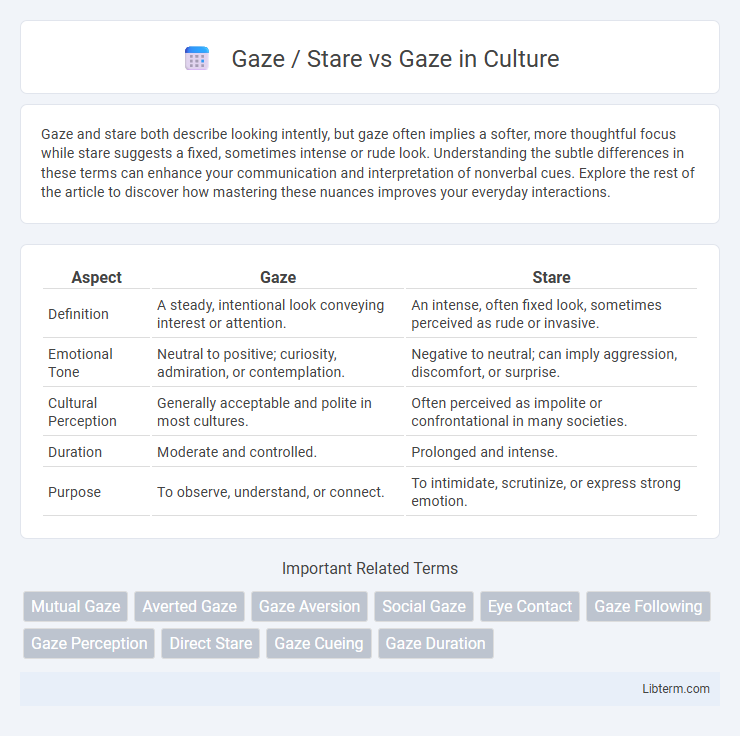Gaze and stare both describe looking intently, but gaze often implies a softer, more thoughtful focus while stare suggests a fixed, sometimes intense or rude look. Understanding the subtle differences in these terms can enhance your communication and interpretation of nonverbal cues. Explore the rest of the article to discover how mastering these nuances improves your everyday interactions.
Table of Comparison
| Aspect | Gaze | Stare |
|---|---|---|
| Definition | A steady, intentional look conveying interest or attention. | An intense, often fixed look, sometimes perceived as rude or invasive. |
| Emotional Tone | Neutral to positive; curiosity, admiration, or contemplation. | Negative to neutral; can imply aggression, discomfort, or surprise. |
| Cultural Perception | Generally acceptable and polite in most cultures. | Often perceived as impolite or confrontational in many societies. |
| Duration | Moderate and controlled. | Prolonged and intense. |
| Purpose | To observe, understand, or connect. | To intimidate, scrutinize, or express strong emotion. |
Understanding the Difference: Gaze/Stare vs Gaze
Understanding the difference between "gaze" and "stare" involves recognizing their distinct emotional and intentional contexts. A gaze denotes a steady, often calm and thoughtful look, typically conveying interest or contemplation, whereas a stare implies a fixed, intense, or intrusive look that can suggest surprise, curiosity, or even rudeness. The subtle nuances in eye behavior signals important social and psychological cues, impacting communication and interpersonal interactions.
Defining "Gaze" and "Stare" in Communication
Gaze refers to a steady, intentional look that conveys interest, attention, or emotional connection in communication, often fostering engagement and understanding between individuals. Stare, in contrast, denotes an extended, fixed look that can imply surprise, discomfort, or judgment, potentially creating awkwardness or tension in social interactions. Understanding the nuances between gaze and stare is crucial for interpreting nonverbal cues and managing interpersonal dynamics effectively.
Psychological Impact of Gazing and Staring
Gazing, characterized by a soft and sustained look, promotes feelings of connection, empathy, and calmness through the release of oxytocin, enhancing social bonding and trust. Staring, however, often triggers discomfort, anxiety, or perceived threat due to its intense and fixed nature, activating the brain's amygdala and stress response systems. Understanding these psychological impacts is crucial in social interactions, as gazing fosters positive emotional engagement while staring can lead to negative emotional and physiological reactions.
Social and Cultural Interpretations of Gaze
Gaze and stare differ significantly in social and cultural contexts, where a gaze often implies voluntary attention or interest, while a stare is perceived as intrusive or confrontational. Cultural norms shape the meaning of gaze behaviors, with some societies interpreting direct eye contact as respect or confidence, and others as disrespect or aggression. Understanding these nuances is essential for intercultural communication, as the interpretation of gaze influences social interactions and power dynamics globally.
The Role of Gaze in Nonverbal Communication
Gaze plays a crucial role in nonverbal communication, signaling attention, interest, and emotional states through eye movement and duration. Unlike a simple stare, which can convey aggression or discomfort, a focused gaze establishes connection and trust between individuals. Understanding subtle differences in gaze behavior enhances interpersonal interactions and social bonding.
Gaze vs Stare: Intentions and Perceptions
Gaze and stare differ significantly in intentions and perceptions, with gaze often implying a voluntary, attentive look conveying interest or curiosity, while stare suggests an intense, fixed look that can be perceived as intrusive or confrontational. Psychological studies highlight gaze as a controlled social signal facilitating communication and connection, whereas staring may trigger discomfort or defensive reactions due to its perceived threat or suspicion. In social and cultural contexts, understanding the nuances between gaze and stare is essential for interpreting nonverbal cues accurately and fostering positive interpersonal interactions.
Power Dynamics Reflected in Eye Contact
Gaze and stare differ significantly in the power dynamics they convey through eye contact, with a gaze often implying mutual respect or interest, while a stare can assert dominance, intimidation, or control. In social and psychological contexts, prolonged eye contact via staring may evoke discomfort or submission, reinforcing hierarchical relationships. Understanding these distinctions is crucial for interpreting nonverbal communication and the underlying power structures in interpersonal interactions.
Gaze in Digital Media and Online Interactions
Gaze in digital media and online interactions functions as a powerful tool for conveying attention, intention, and emotion through virtual eye contact and visual engagement. Unlike a stare, which often implies discomfort or aggression, gaze emphasizes purposeful connection and user focus, enhancing communication effectiveness in video calls, social media, and virtual reality environments. Understanding gaze patterns helps optimize user experience design, eye-tracking technology, and interactive content by aligning digital attention cues with natural human visual behavior.
Managing Gaze in Personal and Professional Settings
Managing gaze effectively in personal and professional settings enhances communication by conveying attentiveness and respect. Maintaining appropriate eye contact during conversations signals confidence and engagement, while avoiding prolonged staring prevents discomfort and misinterpretation. Understanding cultural differences in gaze patterns is crucial for fostering positive interactions and building trust across diverse environments.
Enhancing Awareness: Healthy Eye Contact Practices
Maintaining healthy eye contact through balanced gaze and focused stare techniques significantly enhances social awareness and communication effectiveness. Proper gaze involves a soft, natural look that conveys attentiveness without intimidation, while a focused stare demands controlled intensity, improving perceptual acuity and emotional connection. Developing these eye contact practices supports emotional intelligence, reduces misunderstandings, and fosters deeper interpersonal engagement.
Gaze / Stare Infographic

 libterm.com
libterm.com